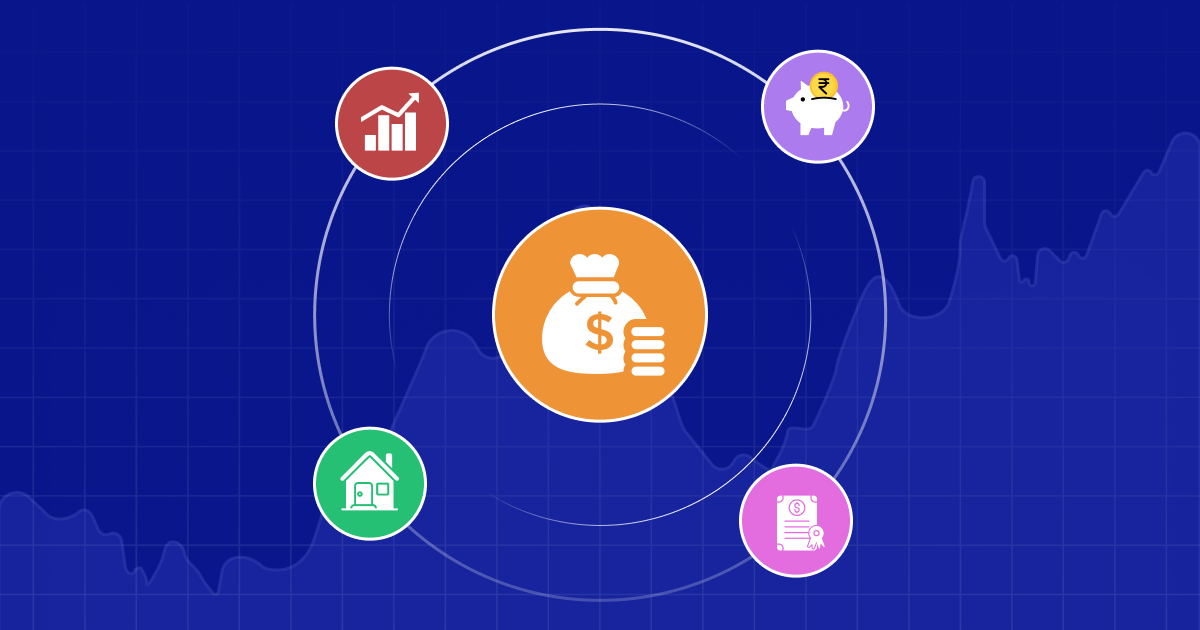
Ten years ago, if you ask any random student in India, ‘What do you want to become in life?’ It would be either a doctor or an engineer.
But things have changed a lot since then. Now there are many career options to choose from, like content writing, fitness coaching, ethical hacking, gaming, video creation, and so on.
Not just career, be it food, car, mobile, or anything under the sun, we have a plethora of choices in front of us. It is one of the perks of living in the 21st century. It also applies to financial assets. Not just any asset but an ‘income-generating asset.’ There are many options available.
In this article, let’s look into top income-generating assets in India and review if it’s suitable for you.
What Are Income-Generating Assets?
Generally, an asset is a resource that is expected to appreciate in economic value over time. It might or might not offer regular income.
On the other hand, income-generating assets deal with assets acquired with the intent to generate consistent cash flow and return on investment over time. Some of the well-known examples are peer-to-peer lending, farmland, cryptos, etc.,
The level of involvement and return potential depends on the asset type.
10 Best Income-Generating Assets to Invest in India
We are touching upon the top 10 income-generating assets available in India.
1. Interest from bank deposits
A bank deposit is one of the easiest and safest ways to generate passive income. There are different types of bank deposits offering interest income to investors.
- Savings Account: You can open a savings account with a local bank and receive interest earnings on your deposit. The annual interest rate of a savings account ranges from 2.5 to 3%.
- Fixed Deposit (FD): Fixed deposits allow you to invest a lump sum amount for a dedicated timeframe in return for interest income. The interest rate varies between 6 to 6.5%.
- Recurring Deposit (RD): Recurring deposits allow people to invest in regular intervals to earn interest income. The interest rates are similar to that of the FD.
2. Peer-to-peer lending
Peer-to-Peer or P2P lending lets retail investors take up the role of a bank and lend money to borrowers.
P2P lending can generate regular income with a minimum of 5 to 7% annual returns, but it involves counterparty risk. It’s the probability that the other party in a transaction may default on their contractual obligations.

3. Pension plans
Pension plans are essentially income-generating assets suitable for senior citizens. The income payouts can be yearly, half-yearly or monthly, depending on the investor’s preferences.
One can expect a 6 to 7.5% return per annum from these pension plans. Pradhan Mantri Vaya Vandana Yojana (PMVVY) is one of the popular pension plans from LIC, offering an annual interest rate of 7.4%.
4. Rental yields from real estate
Real estate is a popular asset class, especially during our parent’s generation.
Rental yields from residential or commercial properties can result in a consistent source of income. Also, there is capital appreciation over the asset. In India, the rental yield is around 2 to 3%, and the average capital appreciation would be about 8%.
If you don’t want to go through the hassle of buying and maintaining physical real estate, REIT is a suitable option for you. REIT stands for Real-Estate Investment Trust, and it is like a mutual fund for real estate. The fund is typically invested in commercial properties like hospitals, hotel chains, office spaces, etc. The average return from REITs falls between 5 to 5.5%.
5. Stocks paying dividends
Stocks refer to owning a piece of business. It can generate income in two ways — price appreciation and dividend payouts.
In particular, dividend payouts can provide a predictable income without much involvement. Below are a couple of examples of dividend stocks with good capital appreciation.
- GAIL (India) Ltd offered a dividend yield of 7.44% and an average return of 13.93% over the last five years.
- The dividend yield of Hindustan Zinc Ltd. is 5.98%, and the five-year average return on investment is 22.72%.
If you are not finding time to analyze direct stocks, you can park your money in active mutual funds or index funds. Let’s take the Nifty 50 index as an example. It is a benchmark index comprising the 50 largest Indian companies listed on National Stock Exchange. The nifty 50 index has given an average annual return of close to 12% since its inception. Also, it provided an average dividend yield of 1.5%.
6. Cryptocurrency
Cryptocurrency is a new-age digital asset class based on blockchain technology.
There are numerous ways to generate money out of cryptos. But for those who want to earn regular income through cryptocurrencies, Mudrex Vault is an excellent option. It is a fixed-income product offering 10% returns annually, with interest credited daily.

7. Websites
One of the popular low-cost investing methods is buying domain names or websites.
Investors can purchase domains that focus on popular topics or upcoming trends. Eventually, they could sell the websites to interested buyers at a higher price.
An alternative strategy is to build the website on your own, add content, generate traffic through affiliate marketing, and earn income from ads.
8. Farmland
Farmland is gaining popularity among millennials who wants to leave their fast-moving lifestyle for a calmer and more peaceful one.
There are multiple ways to generate income through farmlands.
- You can directly involve in cultivating the land, growing farm produce, and selling them in the market. The returns largely depend on the type of produce.
- You can lease your farmland to a farming company for a predictable return.
- You can also invest in REITs focusing on farmlands.
9. Business
Building a business can be a time-consuming task but the most rewarding one. Of course, there is a high likelihood of failure, but it has the potential to generate the highest returns.
The capital requirement depends on the type of business. Digital or freelancing business typically requires lesser up-front investment. While traditional businesses like restaurants, gyms, parlors, etc., require significant capital.
10. Private equity investing
Private equity investing is a suitable option for those who don’t want to build their own business but looking to invest in one.
This is a method where one can invest in private companies or start-ups, especially ones in the early stages. This can be a very attractive avenue for people with more risk appetite, but the capital requirement for entering this space is usually high (at least a few crore rupees).
What Are the Assets I Can Invest in With a Small Budget?
Luckily, there are investment options that require only a minimal entry amount. For example,
- Savings accounts: Minimum balance amount (INR 500 to INR 1000) requested by the bank.
- P2P lending: Few thousand rupees is enough to start P2P lending, but you have to find trustworthy borrowers.
- Dividend-paying stocks: It depends on the number of stocks you want to purchase. But each stock could cost a minimum of a few hundred rupees.
- Business: If it’s a digital business, the cost of building one is minimal. But it requires a lot of effort and time to generate considerable income.
Which Assets Are the Most Profitable?
The profitability of an asset depends on the holding time and the risk associated with it.
The thumb rule is “Higher the risk, higher the returns.” Risky assets like cryptocurrencies, stocks, and private equity investing can be very rewarding, but they come up with higher risks.
On the other hand, safer assets like bank deposits and pension plans can provide stable returns over time.
Income-Generating Assets And Taxation
Most of these assets do attract paying income taxes. However, one can utilize the available exception limits or thresholds to lessen the tax burden. For example,
- Savings account: Annual interest income from savings accounts up to INR 10,000 is not taxable.
- P2P lending: The income from P2P lending doesn’t generally fall under the tax radar as it’s a highly unorganized sector.
- Stocks: Based on the investment tenure, income from stocks can fall under either STCG (Short Term Capital Gain) or LTCG (Long Term Capital Gain) tax.
- Farmland: In India, agricultural income is exempt from taxes.
Conclusion
Many successful people utilize multiple income-generating assets to diversify their income sources and earn regular cash flows.
Irrespective of your age and lifestyle, it is advisable to start investing in these assets. With proper due diligence, you can pick the right assets to help you build your financial cushion.
FAQs
1. Which asset has the highest return?
The profitability of an asset depends on the holding time and the risk associated with it. The thumb rule is “Higher the risk, higher the returns.” Risky assets like cryptocurrencies, stocks, and private equity investing can be very rewarding, but they come up with higher risks.
2. What is the safest asset to invest in?
A bank deposit is regarded as one of the safest avenues to invest your money. Your deposit in a bank is insured under the Deposit Insurance and Credit Guarantee Corporation (DICGC) scheme. The insurance covers your deposits up to INR 5 lakhs for both principal and interest. Thus, your deposit would be safe even if the bank goes insolvent.





